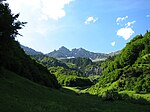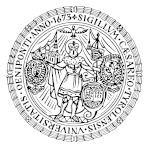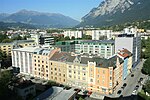Lohbach (Inn)
Austria river stubsRivers of AustriaRivers of Tyrol (state)Tributaries of the Inn
The Lohbach (in its lower range Gießenbach) is a river of Tyrol, Austria, in the municipal area of Innsbruck, a tributary of the Inn. The Lohbach originates from a spring at the eastern edge of the Kranebitter ravine. It runs in eastern direction along Hötting-West and Lohbachsiedlung, further to Vögelebichl. At the street Fischerhäuslweg its name changes to Gießenbach and it runs under ground until it discharges into the Inn. A part of the river branches off and flows into the airport area. The length of the Lohbach is 4.5 kilometres (2.8 mi).
Excerpt from the Wikipedia article Lohbach (Inn) (License: CC BY-SA 3.0, Authors).Lohbach (Inn)
Arthur-Haidl-Promenade, Innsbruck
Geographical coordinates (GPS) Address Nearby Places Show on map
Geographical coordinates (GPS)
| Latitude | Longitude |
|---|---|
| N 47.2658 ° | E 11.3853 ° |
Address
Dr. Salvatore Giacomuzzi
Arthur-Haidl-Promenade 4
6020 Innsbruck (Innsbruck)
Tyrol, Austria
Open on Google Maps








